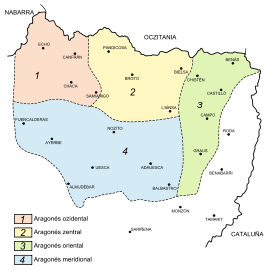Aragonese dialects

The Aragonese language has many local varieties, which are grouped in valley varieties or comarca varieties. The term dialect is ambiguous and it can be used to refer to well-known valley varieties, such as cheso or ansotano. The best-known classification, by Francho Nagore, divides all Aragonese varieties in four groups or main dialects: Western, Central, Southern, and Eastern.
Eastern Aragonese
The eastern area includes a large part of the historic county of Ribagorza, plus eastern parts of Sobrarbe, and has many features in common with Catalan, with increasing similarity as one moves east.
Some common features of the group are:
- Latin plosive consonants become voiced between vowels: meligo (navel), caixigo (type of oak), forau (hole).
- In participles, the voiced Latin -T- was later deleted, giving endings in -au, -iu: cantau, metiu (sung, put in).
- There is a periphrastic past perfect as in modern Catalan: él/ell ba cantá/cantar (he sang).
- Conservation of the adverbial prononun i (< IBI).
- Compared to the other dialects, more cases of evolution of the Latin endings -TY, -CE, -CI, -DE to -u, as in Catalan: peu (foot).
Western Aragonese
The Western Aragonese area corresponds to the Jacetania region, plus part of Alto Gállego and a few towns in Cinco Villas. Western dialects include Ansó Aragonese, Hecho Aragonese, Aragüés Aragonese, and Aísa Aragonese.
Common features:
- Latin plosive consonants are voiced between vowels, but with exceptions, such as gramito or espata. These exceptions might be related to the Gascon dialect.
- Participles, have endings in -au, -iu.
- The 1st and 2nd person plural pronouns are nos and bos.
- Dative pronouns: li, lis.
- Adverbial pronoun bi (< IBI), equivalent to French y, Catalan hi, etc.
Southern Aragonese
Southern dialects include Nevalese. They are the ones more influenced by the Spanish language, and in recent times most of them have lost all but a few of their Aragonese features, merging with the Spanish dialects spoken to the south of the area.
Central Aragonese
Corresponds to part of Alto Gállego and western parts of Sobrarbe. Features:
- Some instances of -ia- diphthong from Latin short E: fiasta (celebration).
- Latin intervocalic stops remain voiceless much more often than in other dialects: capeza (head), saper (to know), lupo (wolf), ayutar (to help).
- This conservation of voiceless stops leads to participles in -ato, -ito.
- Voicing of voiceless stops after liquid consonant: -MP- > -mb-; -NT- > -nd-; -NK- > -ng-; -LT- > -ld-; -RT- > -rd-; -LP- > -lb-; -RK- > -rg-. These rules apply variably for different words and towns.
- In some towns, definite articles ro, ra, ros, ras instead of the general Aragonese o, a, os, as.